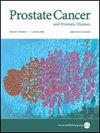对姑息性经尿道前列腺切除术和钬激光前列腺去核术治疗前列腺癌患者膀胱出口梗阻的倾向评分匹配评估
IF 5.1
2区 医学
Q1 ONCOLOGY
引用次数: 0
摘要
背景经尿道前列腺切除术(TURP)是标准的治疗方法,而前列腺钬激光去核术(HoLEP)则被广泛认为是一种与体型无关的方法,用于手术治疗因膀胱出口梗阻(BOO)而继发下尿路症状(LUTS)的患者。然而,在老龄化社会中,越来越多的患者因局部晚期前列腺癌而出现膀胱出口梗阻。目前还没有关于去核或切除技术的指南建议。因此,我们比较了姑息性(p)TURP 和(p)HoLEP 的术中表现、术后结果和安全性。方法 我们对 2014 年至 2021 年间分别接受 TURP 或 HoLEP 治疗 LUTS/BOO 的 1373 名和 2705 名男性患者进行了回顾性倾向评分匹配分析。患者的年龄、前列腺大小和术前国际前列腺症状评分(IPSS)均匹配。结果无论采用哪种技术,术后症状和尿动力学参数都有所改善,但我们发现姑息适应症的切除和去核时间明显增加。就相应的效率参数而言,我们观察到在无前列腺癌的患者中,两种技术的手术效果(克/分钟)均提高了两倍。虽然两组患者的不良反应相当,但我们发现姑息治疗患者的血红蛋白下降率比对照组高出两倍。我们的数据显示,TURP 和 HoLEP 都能充分改善症状,安全性也相当。虽然 HoLEP 即使对较大的前列腺也是可行的,但对于前列腺癌患者来说,这两种手术都变得更加困难。综上所述,这项研究填补了目前文献中的一个重要空白,有助于泌尿外科医生做出循证决策,造福患者。本文章由计算机程序翻译,如有差异,请以英文原文为准。
Propensity score-matched evaluation of palliative transurethral resection and holmium laser enucleation of the prostate for bladder outlet obstruction in patients with prostate cancer
While transurethral resection of the prostate (TURP) is the standard-of-care, Holmium laser enucleation of the prostate (HoLEP) is widely accepted as a size-independent method for surgical treatment of patients with lower urinary tract symptoms (LUTS) secondary to bladder outlet obstruction (BOO). However, in an ageing society an increasing number of patients presents with BOO due to locally advanced prostate cancer. There is currently no guidelines recommendation as to the enucleation or resection technique. Therefore, we compared intraoperative performance, postoperative outcomes, and safety for palliative (p)TURP and (p)HoLEP. We conducted a retrospective, propensity score-matched analysis of 1373 and 2705 men who underwent TURP or HoLEP for LUTS/BOO between 2014 and 2021, respectively. Patients were matched for age, prostate size and preoperative international prostate symptom score (IPSS). Patients were stratified by technique and groups were compared for perioperative parameters, safety, and functional outcomes. While postoperative symptoms and urodynamic parameters improved irrespective of technique, we report significantly increased resection and enucleation times for palliative indication. For corresponding efficiency parameters, we observed a two-fold higher surgical performance (g/min) for both techniques in patients without prostate cancer. While adverse events were comparable between groups, we found a two-fold higher hemoglobin drop in palliative patients. Currently, there is no standard-of-care for patients with BOO and locally advanced prostate cancer. Our data show that both TURP and HoLEP offer adequate symptom improvement and comparable safety profiles. While HoLEP is feasible even in larger prostates, both procedures become more difficult in patients with prostate cancer. Taken together, this study covers an important gap in current literature, helping urological surgeons to make evidence-based decisions for the benefit of their patients.
求助全文
通过发布文献求助,成功后即可免费获取论文全文。
去求助
来源期刊

Prostate Cancer and Prostatic Diseases
医学-泌尿学与肾脏学
CiteScore
10.00
自引率
6.20%
发文量
142
审稿时长
6-12 weeks
期刊介绍:
Prostate Cancer and Prostatic Diseases covers all aspects of prostatic diseases, in particular prostate cancer, the subject of intensive basic and clinical research world-wide. The journal also reports on exciting new developments being made in diagnosis, surgery, radiotherapy, drug discovery and medical management.
Prostate Cancer and Prostatic Diseases is of interest to surgeons, oncologists and clinicians treating patients and to those involved in research into diseases of the prostate. The journal covers the three main areas - prostate cancer, male LUTS and prostatitis.
Prostate Cancer and Prostatic Diseases publishes original research articles, reviews, topical comment and critical appraisals of scientific meetings and the latest books. The journal also contains a calendar of forthcoming scientific meetings. The Editors and a distinguished Editorial Board ensure that submitted articles receive fast and efficient attention and are refereed to the highest possible scientific standard. A fast track system is available for topical articles of particular significance.
 求助内容:
求助内容: 应助结果提醒方式:
应助结果提醒方式:


